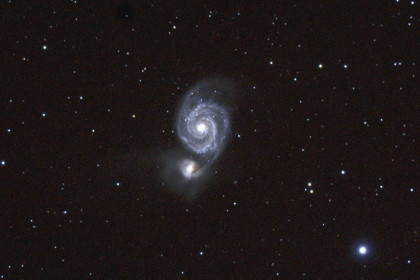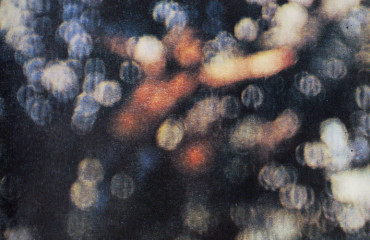
THE PLANETS
MERCURY: is observable between the crack of dawn in the early days of the month; on the 18th it reaches its maximum distance from the Sun and it is the best time to be viewed.
VENUS: is the star that dominates the evening sky; its proximity to Jupiter and the Pleiades cluster is always beautiful. It is interesting to film the stages of planet that, being an inner planet, looks in various phases like the Moon and not always as a circle. At the beginning of the month you can admire Venus’ daily apparently fast motion on the starry sky, using as a reference the Pleiades. The planet is combined with M45 on the 3rd and after the sunset. To the West you can see Jupiter, but very low on the horizon.
MARS: is still clearly observable for most of the night, it is the planet that is useful for filming to capture the elusive superficial formations. For the problem of atmospheric turbulence, greatly worsened in recent years, from our experience, we recommend using a high quality telescope and a diameter not exceeding 150 mm.
JUPITER: in the evening, just after the Sun sets, you can still do good visual observations, while, due to its proximity with the Sun, the season of photographic shots of its atmospheric formations can be considered terminated.
SATURN: despite its lower declination in this month, on April 15th it reaches the opposition – the most favourable period, from dusk till dawn – for filming and observations of spectacular rings and the suggestive Cassini Division.
URANUS: not observable.
NEPTUNE: observable shortly before dawn with a little difficulty because of its small apparent diameter, a simple pair of binoculars should be used.
A DOUBLE STAR PER MONTH
This April our interest is addressed to a constellation which, for lovers of double stars, is a real joy and encloses the most beautiful stars of Spring sky: we are watching the ancient Boöte constellation whose interpretations were many: shepherd, guardian of the herd, Bernese mountain dog, hick and farmer. Boöte is recognizable by an alpha star of first magnitude, the yellow Arturo, the fourth star of the heaven in order of brightness because of its just 37 a.l. proximity, you find easily by the ideal extension of the helm of Great Dipper or Great Bear.
From Arturo, moving approximately 10 degrees North-East, we find an epsilon orange star, Boöte: its real name, of Arabic origin, is Izar. The two stars that make up Izar have enchanting contrasting colours: yellow-orange the main one (mag 2.7) and blue the secondary one (5.1 mag). Struve, one of the great discoverers and observers of double stars in the nineteenth century, called this pair ‘“pulcherrima”, beautiful, and philosopher and scientist Flammarion termed the delightful couple with the bright yellow and sea blue companion and concluded with the statement “you would want to live there”.
The fact that Izar is composed of two very bright stars makes observation with small or poor quality telescopes tricky, in my just 78mm diameter fluorite apochromatic it is an easy pair at 178 magnifications, other observers encounter difficulties in the separation and identification of colours despite the use of mirror telescopes with diameters well more generous but blocked by the presence of the secondary.
THE OBJECT OF THE MONTH: The M-51 SPIRAL GALAXY (VORTEX)
The most interesting object in the Canes Venatici constellation is M-51 located about 3.5 degrees southwest of Ursa Major Eta. It is a Double Galaxy viewed almost perfectly flat, dubbed the “Whirlpool Galaxy”. M51 is visible with binoculars, with a telescope you can see the dual conformation while to be able to see more details of its structure at least 20 cm telescopes are needed.
The Galaxy Companion is NGC5195, a little further away than M51, although they seem the same distance as they are physically linked by a bridge. M51 was discovered by C. Messier in 1773 and its beautiful spiral structure was observed by Lord Ross in 1847 in Ireland with the most powerful telescope at the time. Lord Ross was the first to recognize the spiral galaxy shape and his telescope was for many decades the distinction of largest instrument in the world.
Until the last century it was thought that M-51 was a solar system in formation. Only in the 1920s, thanks to powerful new telescopes, we realized that it was outside our galaxy. The distance is greater than 35 million light-years away and the size is just over 100000 light-years. Consisting of over 100 billion stars it is, on the whole, similar in size to the milky way
Other celestial objects observed during this period with a binocular:
M-51 Whirlpool Galaxy
M-65 and M66 Galaxies clearly visible with binoculars in Leo just below star Theta Leonis.
M-44 open star cluster of the crib.
M95 and M96 Galaxies clearly visible with binoculars in Leo halfway between the stars Theta and Alpha Leonis.
SPRING
With the arrival of spring the days become longer and the nights are becoming increasingly shorter and warmer. The observation of the sky done this season is certainly more enjoyable. The constellation of the spring is the Great Bear particularly the part which includes the tail of Bear, also known as the Big Dipper. During this time, the Big Dipper is visible at Zenith, easily identifiable by the seven stars that compose it. Starting from Big Dipper you can recognize the three stars Regulus and Spica, Arcturus, which form the so-called spring Triangle.
To find Regulus in the Leo constellation, simply extend the arch formed by Polaris and Dubhe and Merak two stars of the Big Dipper southward: Regulus is the brightest star that lies in the extension. To find Arcturus and Spica is necessary to prolong the arch formed by the first three stars of the Big Dipper (Alioth, Mizar and Benetnasch), forming the helm of the Big Dipper. The first bright star that will meet is Arturo in Boöte, the second Spica in Virgo. Having thus located first the Great Bear and then Leo, Virgo and Boöte, we will be able to find all the other spring constellations.
During the spring season are two swarms of meteors visible: The first is that of Lyrids because it seems that the meteors come from Lyra, observable in the second half of the night. For this it is said that the Lyrids have radiant in Lyra. The swarm is not very rich and formed by fast meteors. The maximum intensity is reached on 21 April, while the duration ranges from 19 to 22 April. Another spring swarm is called Eta Aquaridi; it presents the radiant in Aquarius and peaks on May 4th. The swarm lasts from 1 to 13 May and consists of fast meteors that leave a very long tracks.
EVENTS OF THE MONTH
April 3rd 6:16 PM – the Moon in conjunction with Regulus (Moon 6.3° South of Alpha Leonis; best condition for observation after sunset at 8:10 PM)
April 7th 6:59 PM – Moon in perigee 358,315 km
April 15th 8:26 PM -Saturn in opposition to the Sun
April 16th 6:50 AM- Mars at maximum distance from Regulus (Mars 4° .3 east of Alpha Leonis)
April 16th 7:00 PM – Maximum Lunar libration in latitude. South Pole visible ( -6° .7)
April 18th 7:13 PM – Mercury at greatest elongation (27° .5) from the Sun
April 22nd 07:26 AM – Peak of the Lyrids Meteor observable from 17 to 26 April
April 22nd 3:47 PM – Moon at Apogee (406,419 km)
April 22nd 9:49 PM – Moon and Jupiter in conjunction (Moon 1° .8 north of Jupiter)
April 23rd 6:28 PM – Moon conjunct with Pleiades (Moon 4° South of M45) best observable condition shortly after sunset around the 8:30 PM
April 25th 4:15 AM -Moon and Venus in conjunction (Moon 6° .5 South of Venus-elong. 42° E) best observable condition before the Moon sets around 11:10 PM on the previous day.
April 29th -maximum Lunar libration in longitude. Eastern edge visible ( -8° .01)
 English
English  Italiano
Italiano 



